Punjab State Board PSEB 12th Class Maths Book Solutions Chapter 7 Integrals Ex 7.4 Textbook Exercise Questions and Answers.
PSEB Solutions for Class 12 Maths Chapter 7 Integrals Ex 7.4
Question 1.
\(\frac{3 x^{2}}{x^{6}+1}\)
Solution.
∫ \(\frac{3 x^{2}}{x^{6}+1}\) dx = ∫ \(\frac{3 x^{2}}{\left(x^{3}\right)^{2}+1}\) dx
Let x3 = t
⇒ 3x2 dx = dt
⇒ dx = \(\frac{d t}{3 x^{2}}\)
∫ \(\frac{3 x^{2}}{\left(x^{3}\right)^{2}+1}\) dx = ∫ \(\frac{d t}{t^{2}+1}\)
= tan-1 t + C
= tan-1 (x3) + C
![]()
Question 2.
\(\frac{1}{\sqrt{1+4 x^{2}}}\)
Solution.
∫ \(\frac{1}{\sqrt{1+4 x^{2}}}\) dx = ∫ \(\) dx
Let 2x = t
⇒ 2 dx = dt
⇒ dx = \(\frac{1}{2}\)
∴ \(\int \frac{1}{\sqrt{1+4 x^{2}}} d x=\frac{1}{2} \int \frac{d t}{\sqrt{1+t^{2}}}\)
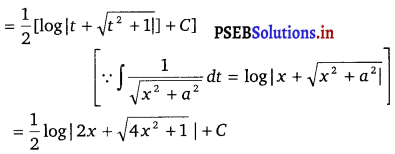
![]()
Question 3.
\(\frac{1}{\sqrt{(2-x)^{2}+1}}\)
Solution.
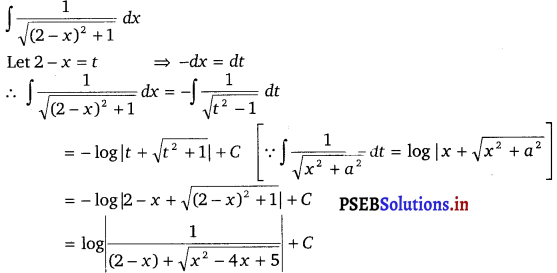
Question 4.
\(\frac{1}{\sqrt{9-25 x^{2}}}\)
Solution.
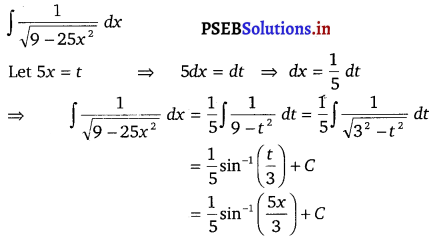
![]()
Question 5.
\(\frac{3 x}{1+2 x^{4}}\)
Solution.
∫ \(\frac{3 x}{1+2 x^{4}}\) dx = \(\frac{3}{2} \int \frac{x d x}{\frac{1}{2}+x^{4}}=\frac{3}{2} \int \frac{x d x}{\frac{1}{2}+\left(x^{2}\right)^{2}}\)
Let x2 = t
⇒ 2x = \(\frac{d t}{d x}\)
⇒ dx = \(\frac{d t}{2 x}\)
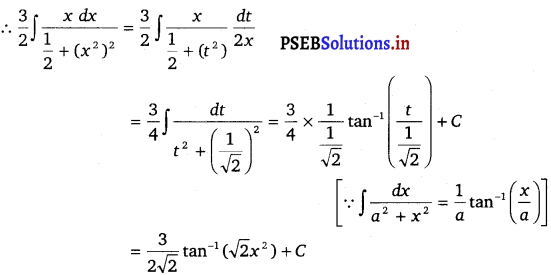
Question 6.
\(\frac{x^{2}}{1-x^{6}}\)
Solution.
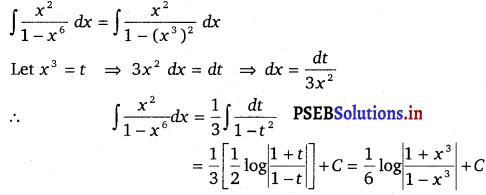
![]()
Question 7.
\(\frac{x-1}{\sqrt{x^{2}-1}}\)
Solution.
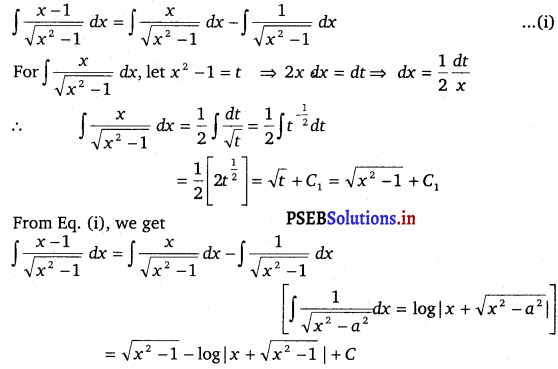
Question 8.
\(\frac{x^{2}}{\sqrt{x^{6}+a^{6}}}\)
Solution.
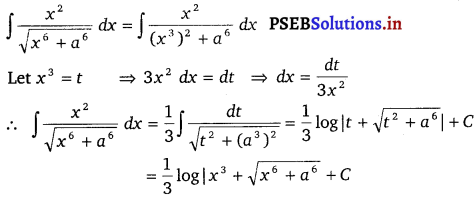
![]()
Question 9.
\(\frac{\sec ^{2} x}{\sqrt{\tan ^{2} x+4}}\)
Solution.
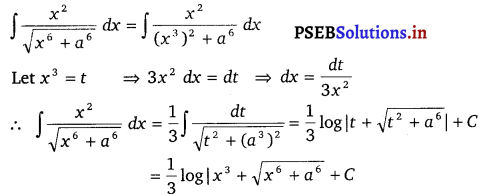
Question 10.
\(\frac{1}{\sqrt{x^{2}+2 x+2}}\)
Solution.
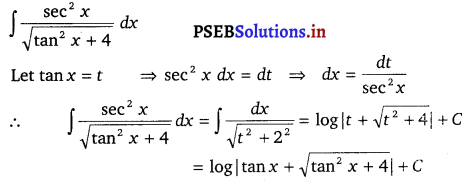
![]()
Question 11.
\(\frac{1}{9 x^{2}+6 x+5}\)
Solution.
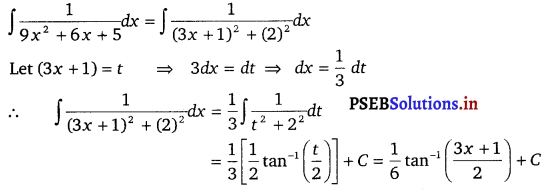
Question 12.
\(\frac{1}{\sqrt{7-6 x-x^{2}}}\)
Solution.
7 – 6x – x2 can be written as 7 – (x2 + 6x + 9 – 9).
Therefore, 7 – (x2 + 6x + 9 – 9) = 16 – (x2 + 6x + 9)
= 16 – (x + 3)2
= (4)2 – (x + 3)2
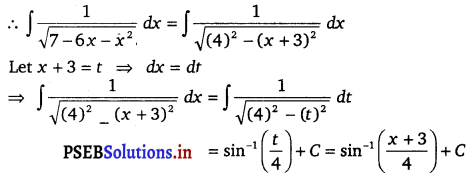
![]()
Question 13.
\(\frac{1}{\sqrt{(x-1)(x-2)}}\)
Solution.
(x – 1) (x – 2) can be written as x2 – 3x + 2

Question 14.
\(\frac{1}{\sqrt{8+3 x-x^{2}}}\)
Solution.
8 + 3x – x2 can be written as – (x2 – 3x + \(\frac{9}{4}\) – \(\frac{9}{4}\))
Therefore, 8 – (x2 – 3x + \(\frac{9}{4}\) – \(\frac{9}{4}\)) = \(\frac{41}{4}-\left(x-\frac{3}{2}\right)^{2}\)

![]()
Question 15.
\(\frac{1}{\sqrt{(x-a)(x-b)}}\)
Solution.
(x – a) (x – b) can be written as x2 – (a + b) x + ab
Therefore,

Question 16.
\(\frac{4 x+1}{\sqrt{2 x^{2}+x-3}}\)
Solution.
∫ \(\frac{4 x+1}{\sqrt{2 x^{2}+x-3}}\) dx
Let 2x2 + x – 3 = t
⇒ (4x + 1) dx = dt
⇒ dx = \(\frac{d t}{4 x+1}\)
= \(\int \frac{d t}{\sqrt{t}}=\int t^{-\frac{1}{2}} d t=\frac{t^{-\frac{1}{2}+1}}{\frac{1}{2}}+C=2 \sqrt{t}+C\)
= 2 \(\sqrt{2 x^{2}+x-3}\) + C
![]()
Question 17.
\(\frac{x+2}{\sqrt{x^{2}-1}}\)
Solution.
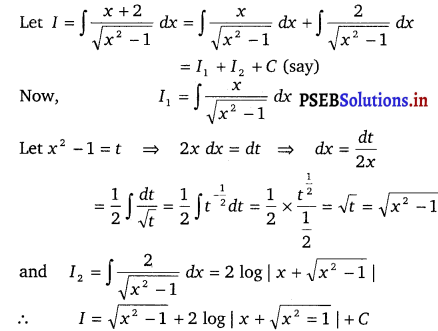
Question 18.
\(\frac{5 x-2}{1+2 x+3 x^{2}}\)
Solution.
Let 5x – 2 = A \(\frac{d}{d x}\) (1 +2x + 3x2) + B
⇒ 5x – 2 = A (2 + 6x) + B
Equating the coefficient of x and constant term on both sides, we get
5 = 6A
⇒ A = \(\frac{5}{6}\) ;
2A + B = – 2
⇒ B = – \(\frac{11}{3}\)
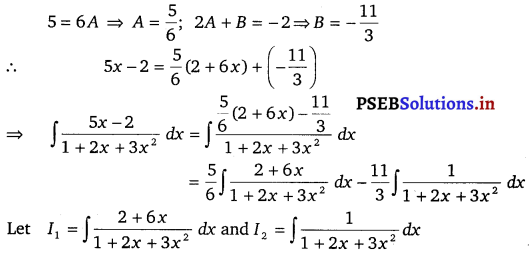
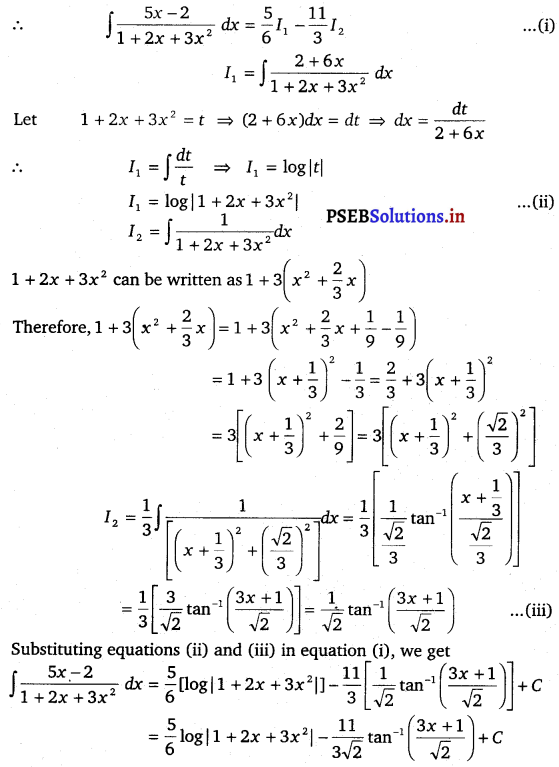
![]()
Question 19.
\(\frac{6 x+7}{\sqrt{(x-5)(x-4)}}\)
Solution.
\(\frac{6 x+7}{\sqrt{(x-5)(x-4)}}=\frac{6 x+7}{\sqrt{x^{2}-9 x+20}}\)
Let 6x + 7 = A \(\frac{d}{d x}\) (x2 – 9x + 20) + B
⇒ 6x + 7 = A (2x – 9) + B
Equating the coefficients of x and constant term, we get
2A = 6
⇒ A = 3;
– 9A + B = 7
⇒ B = 34
∴ 6x + 7 = 3 (2x – 9) + 34
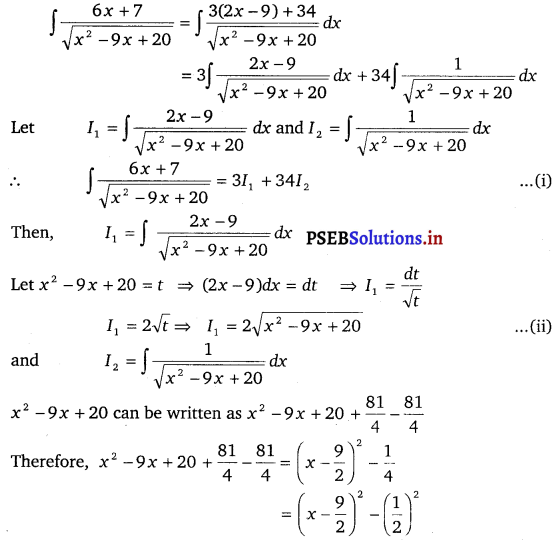
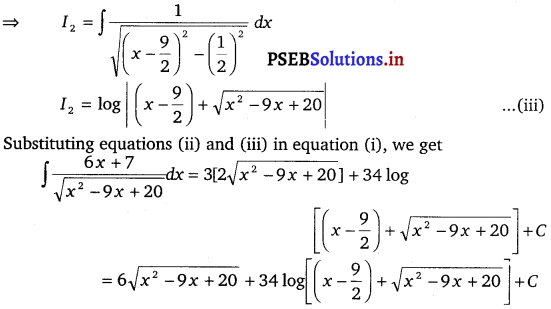
![]()
Question 20.
\(\frac{x+2}{\sqrt{4 x-x^{2}}}\)
Solution.
∫ \(\frac{x+2}{\sqrt{4 x-x^{2}}}\) dx
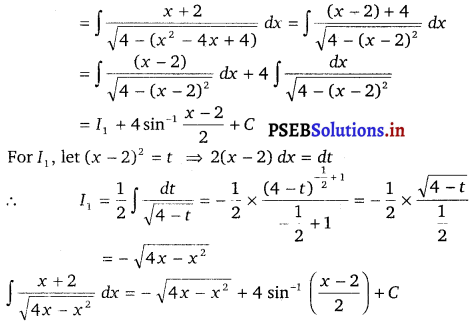
Question 21.
\(\frac{x+2}{\sqrt{x^{2}+2 x+3}}\)
Solution.
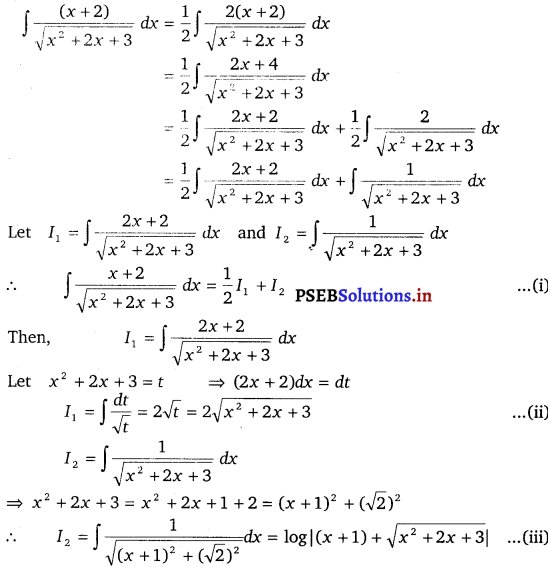
Substituting equations (ii) and (iii) in equation (i), we get
∫ \(\frac{x+2}{\sqrt{x^{2}+2 x+3}}\) dx = \(\frac{1}{2}\left[2 \sqrt{x^{2}+2 x+3}\right]+\log \mid(x+1)+\sqrt{x^{2}+2 x+3 \mid}\)
= \(\sqrt{x^{2}+2 x+3}+\log \mid(x+1)+\sqrt{x^{2}+2 x+3 \mid}\) + C
![]()
Question 22.
\(\frac{x+3}{x^{2}-2 x-5}\)
Solution.
Let (x + 3) = A \(\frac{d}{d x}\) (x2 – 2x – 5) + B
⇒ (x + 3) = A (2x – 2) + B
⇒ x + 3 = 2Ax – 2A + B
On equating the coefficients of x and constant term on both sides, we get
2A = 1
⇒ A = \(\frac{1}{2}\);
– 2A + B = 3
⇒ B = 4
⇒ (x + 3) = \(\frac{1}{2}\) (2x – 2) + 4
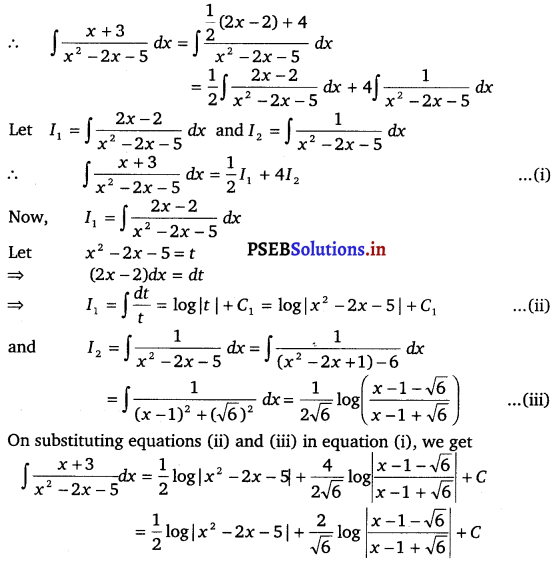
Question 23.
\(\frac{5 x+3}{\sqrt{x^{2}+4 x+10}}\)
Solution.
Let 5x + 3 = A \(\frac{d}{d x}\) (x2 + 4x + 10) + B
⇒ 5x + 3 = A (2x + 4) + B
⇒ 5x + 3 = 2Ax + 4A + B
On equating the coefficients of x and constant term, we get
2A = 5
A = \(\frac{5}{2}\);
4A + B = 3
⇒ B = – 7
⇒ 5x + 3 = (2x + 4) – 7
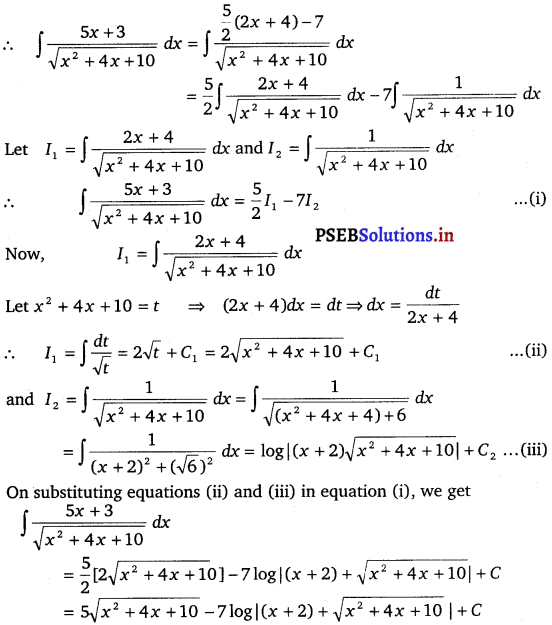
![]()
Direction (24 – 25): Choose the correct answer:
Question 24.
∫ \(\int \frac{d x}{x^{2}+2 x+2}\) equals
(A) x tan-1 (x + 1) + C
(B) tan-1 (x + 1) + C
(C) (x + 1) tan-1 x + C
(D) tan-1 x + C
Solution.
∫ \(\int \frac{d x}{x^{2}+2 x+2}\) dx = \(\int \frac{d x}{\left(x^{2}+2 x+1\right)+1}=\int \frac{1}{(x+1)^{2}+(1)^{2}} d x\)
Let x + 1 = t
⇒ dx = dt
∴ ∫ \(\frac{1}{t^{2}+1^{2}}\) dt = \(\frac{1}{1} \tan ^{-1}\left(\frac{t}{1}\right)\) + C
= tan \(\left(\frac{x+1}{1}\right)\) + C
= tan-1 (x + 1) + C
Hence, the correct answer is (B).
![]()
Question 25.
∫ \(\frac{d x}{\sqrt{9 x-4 x^{2}}}\) equals
(A) \(\frac{1}{9} \sin ^{-1}\left(\frac{9 x-8}{8}\right)\) + C
(B) \(\frac{1}{2} \sin ^{-1}\left(\frac{8 x-9}{9}\right)\)
(C) \(\frac{1}{3} \sin ^{-1}\left(\frac{9 x-8}{8}\right)\)
(D) \(\frac{1}{2} \sin ^{-1}\left(\frac{9 x-8}{9}\right)\)
Solution.
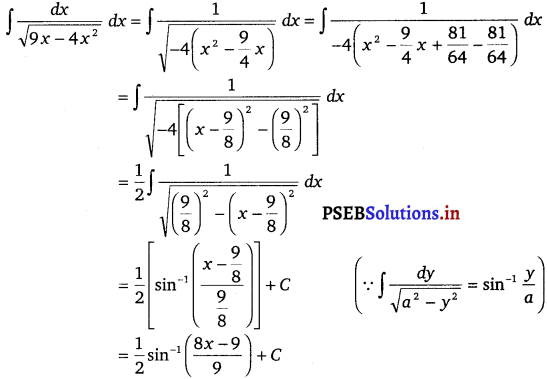
Hence, the correct answer is (B).
